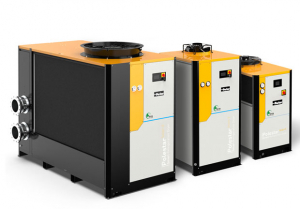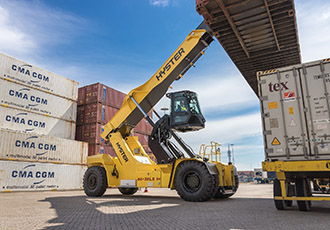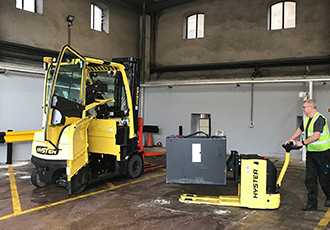60% savings on Full Wave / AC Vibrators
27th October 2009
Source:
Elscint Automation
Electricity costs are increasing day by day. In this scenario, it is the duty of every person to look for ways to reduce electricity / power costs in industry. Vibratory feeders are one area where one can look for power savings and subsequent cost reductions. In many cases, costs can be reduced by as much as 40% to 60% if full wave AC operated vibratory feeders are used instead of conventional DC / half wave feeders.
While full wave vibratory feeders i.e. with electromagnetic AC drives have been available for a long time, only a few manufacturers manufacture these type of vibratory feeders. However, as energy costs have started to increase exponentially and energy sources are scarce in most countries, companies have began to realize that the electromagnetic AC drive (full wave) vibratory feeders vibratory feeders can offer a significant cost savings in power consumption while also improving the performance of the vibratory feeders.
The conventional DC operated / half wave electromagnetic vibratory feeders operate with an inefficient attract release system. A spring mounted moving mass is alternately attracted by a rectified pulsating direct current electromagnet (requiring a highly power consuming rectifier) and returns to its original position solely by the springs.
The full wave AC operated, variable speed electromagnetic drive system, on the other hand, incorporates a magnet (part of a spring mounted moving mass). The poles of the magnet are intermeshed with those of an electromagnet, which is powered directly by an alternating current line. This results in the spring-mounted moving mass being both attracted and repelled by the full wave / AC electromagnet equally on each half of the AC cycle.
The poles of the magnet are intermeshed in the air gaps of the AC electromagnet. The polarity of the magnet is fixed, while the polarity of the electromagnet alternates at line frequency. The electromagnet polarity is shown as it exists on one side of the AC sine wave. Both poles of the magnet are attracted toward the unlike electromagnet poles while being repelled in the same direction by the like poles. Thus, four forces are acting together to drive the armature and moving mass in the same direction.
This action has the effect of progressively closing the magnetizing circuit through the electromagnet core, providing a progressively increasing magnetizing force upon the magnet. The demagnetizing force is very minor, since the action described also has the effect of progressively opening the demagnetizing circuit.
On the opposite side of the sine wave, the polarities of the electromagnet are reversed. The armature is driven in the opposite direction, and a net magnetizing force once again acts on the magnet. A predominant magnetizing force always works upon the magnet, which prevents it from losing its strength.
Advantages of Full Wave / AC Drive Feeders
1. Highly Accurate - Since the amplitude of the vibrator feeder’s vibration depends directly upon the forces applied at the poles, and since these forces depend directly upon the applied AC voltage, a simple variation of the AC voltage from zero to 100% results in a corresponding amplitude variation from zero to 100%. With a half wave or DC vibratory feeder, a 10% increase in voltage might result in a 40% increase in feed; with a full wave or AC drive feeder, a 10% increase in voltage results in a 10% increase in feed. This level of accuracy makes the feeding much easier to control.
2. No Rectifier required – Full wave / AC vibrators do not require a rectifier, which means the vibrators consume less power resulting in huge energy savings. (upto 60%)
3. Lower Maintenance – Full wave / AC Vibrators require less maintenance as the vibrations are smooth and not jerky, thus resulting in lesser breakages.
4. Smoother Vibrations – The vibrations are smooth and not jerky, hence are most suitable for fragile and light weight components.
Though there are tremendous advantages like increased feed accuracy, energy savings and lower maintenance requirements, there are no disadvantages or trade-offs in speed or capacity. The full wave drive feeders can handle light as well as bulky and heavy components at high speeds.
However, while the full wave / AC drive units provide increased feed accuracy, energy savings and lower maintenance requirements, there are no disadvantages or trade-offs in speed or capacity. The full wave / AC drive feeders can handle light as well as bulky and heavy components at high speeds.
Energy / power costs will continue to rise in the future as demand threatens to exceed the available supply. Fortunately, making even minor changes to a materials handling operation can significantly reduce power consumption. In many cases, using full wave or AC operated, variable-speed electromagnetic feeders instead of DC drive attract release feeders can help manufacturers save energy while also increase feed accuracy.
Cost Savings
Putting down the savings in monetary terms, a full wave / AC powered vibratory bowl feeder with a rating of 780 VA (having diameter 600 mm to 650 mm), results in power consumption of 3.6 units per eight hours while the equivalent half wave / DC operated vibratory feeder would result in power consumption of about 9 units per eight hours. The savings can thus be monetized at 5.4 units per eight hours i.e. 146 units per month. At the prevailing rate of Rs. 8 (16 cents per unit), it results in savings of Rs. 1168 (US $ 23) per month by just running just one shift per month.
Changeover to Full Wave vibratory feeders
Looking at the above cost savings, does it make sense to dump your present half wave vibratory feeder in favour of a full wave / AC operated one? It sure does. You can recover the price of a new full wave / AC operated vibratory feeder very soon!
The conventional DC operated / half wave electromagnetic vibratory feeders operate with an inefficient attract release system. A spring mounted moving mass is alternately attracted by a rectified pulsating direct current electromagnet (requiring a highly power consuming rectifier) and returns to its original position solely by the springs.
The full wave AC operated, variable speed electromagnetic drive system, on the other hand, incorporates a magnet (part of a spring mounted moving mass). The poles of the magnet are intermeshed with those of an electromagnet, which is powered directly by an alternating current line. This results in the spring-mounted moving mass being both attracted and repelled by the full wave / AC electromagnet equally on each half of the AC cycle.
The poles of the magnet are intermeshed in the air gaps of the AC electromagnet. The polarity of the magnet is fixed, while the polarity of the electromagnet alternates at line frequency. The electromagnet polarity is shown as it exists on one side of the AC sine wave. Both poles of the magnet are attracted toward the unlike electromagnet poles while being repelled in the same direction by the like poles. Thus, four forces are acting together to drive the armature and moving mass in the same direction.
This action has the effect of progressively closing the magnetizing circuit through the electromagnet core, providing a progressively increasing magnetizing force upon the magnet. The demagnetizing force is very minor, since the action described also has the effect of progressively opening the demagnetizing circuit.
On the opposite side of the sine wave, the polarities of the electromagnet are reversed. The armature is driven in the opposite direction, and a net magnetizing force once again acts on the magnet. A predominant magnetizing force always works upon the magnet, which prevents it from losing its strength.
Advantages of Full Wave / AC Drive Feeders
1. Highly Accurate - Since the amplitude of the vibrator feeder’s vibration depends directly upon the forces applied at the poles, and since these forces depend directly upon the applied AC voltage, a simple variation of the AC voltage from zero to 100% results in a corresponding amplitude variation from zero to 100%. With a half wave or DC vibratory feeder, a 10% increase in voltage might result in a 40% increase in feed; with a full wave or AC drive feeder, a 10% increase in voltage results in a 10% increase in feed. This level of accuracy makes the feeding much easier to control.
2. No Rectifier required – Full wave / AC vibrators do not require a rectifier, which means the vibrators consume less power resulting in huge energy savings. (upto 60%)
3. Lower Maintenance – Full wave / AC Vibrators require less maintenance as the vibrations are smooth and not jerky, thus resulting in lesser breakages.
4. Smoother Vibrations – The vibrations are smooth and not jerky, hence are most suitable for fragile and light weight components.
Though there are tremendous advantages like increased feed accuracy, energy savings and lower maintenance requirements, there are no disadvantages or trade-offs in speed or capacity. The full wave drive feeders can handle light as well as bulky and heavy components at high speeds.
However, while the full wave / AC drive units provide increased feed accuracy, energy savings and lower maintenance requirements, there are no disadvantages or trade-offs in speed or capacity. The full wave / AC drive feeders can handle light as well as bulky and heavy components at high speeds.
Energy / power costs will continue to rise in the future as demand threatens to exceed the available supply. Fortunately, making even minor changes to a materials handling operation can significantly reduce power consumption. In many cases, using full wave or AC operated, variable-speed electromagnetic feeders instead of DC drive attract release feeders can help manufacturers save energy while also increase feed accuracy.
Cost Savings
Putting down the savings in monetary terms, a full wave / AC powered vibratory bowl feeder with a rating of 780 VA (having diameter 600 mm to 650 mm), results in power consumption of 3.6 units per eight hours while the equivalent half wave / DC operated vibratory feeder would result in power consumption of about 9 units per eight hours. The savings can thus be monetized at 5.4 units per eight hours i.e. 146 units per month. At the prevailing rate of Rs. 8 (16 cents per unit), it results in savings of Rs. 1168 (US $ 23) per month by just running just one shift per month.
Changeover to Full Wave vibratory feeders
Looking at the above cost savings, does it make sense to dump your present half wave vibratory feeder in favour of a full wave / AC operated one? It sure does. You can recover the price of a new full wave / AC operated vibratory feeder very soon!
Similar articles
More from Elscint Automation
- Elscint Vibratory Bowl Feeder for feeding Camphor Tablets 22nd April 2013
- Elscint Vibratory Bowl Feeder for feeding small Pins 19th February 2013
- Elscint Rotary / Centrifugal Feeder 11th February 2013
- Vibratory Drive for Bausch + Stroebel bowl 30th October 2012




.jpg)







Write a comment
No comments